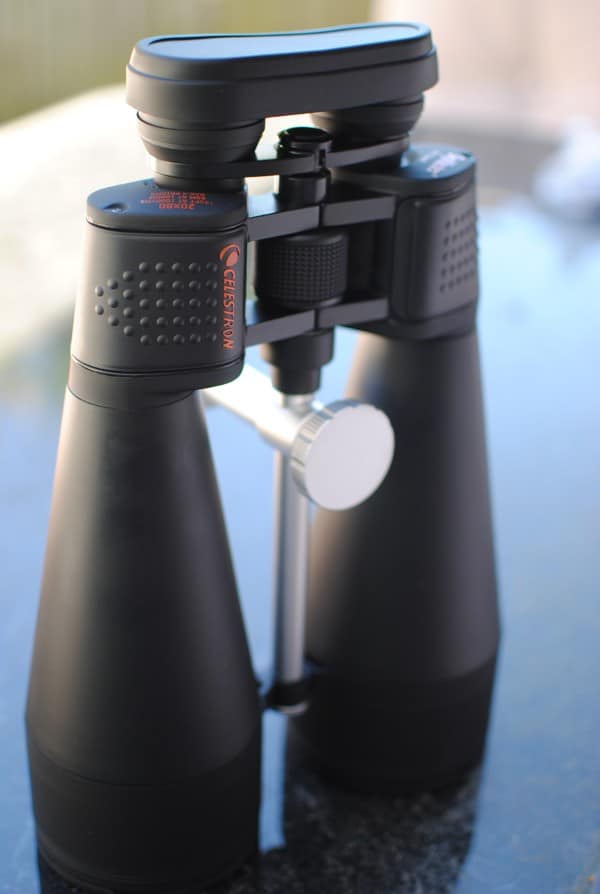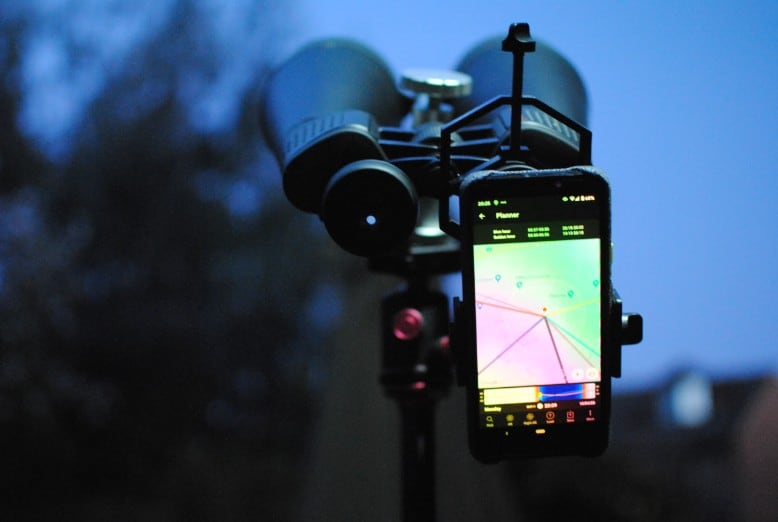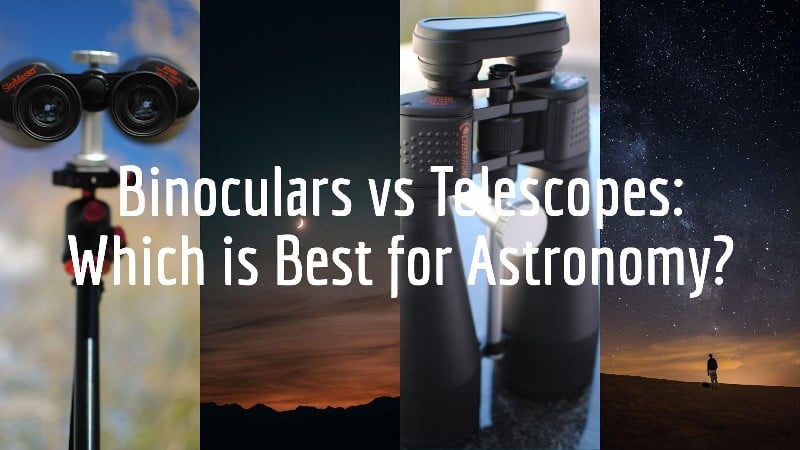When most people think about getting a piece of equipment for viewing the night sky they assume that they need a telescope.
However, binoculars have a number of advantages that can make them a good option to telescopes for many people.
In this article, we explore the pros and cons of binoculars vs telescopes to help you decide what is right for you.
Our focus is in relation to astronomy and astrophotography, but we do also touch on other terrestrial uses.

What is the Difference Between a Telescope and Binoculars?
A telescope is a single optical tube that you look through via an eyepiece. They are designed to give you clear and magnified views of far-off objects, in particular astronomical objects in space.
Binoculars are optical devices with two optical tubes and eyepieces that you look through with both eyes. Regular binoculars are usually fairly small and are designed to be used handheld, however larger astronomy binoculars can be much bigger and need to be used with a tripod.
Let’s now dig into the key differences between telescopes and binoculars:
- Size and weight: Telescopes can range from fairly small and fitting in a backpack to absolutely huge and bigger than a person. Binoculars are usually fairly small and light, however some bigger models can be large and heavy.
- Portability: Given the smaller size and lower weight of binoculars, they are naturally easier to travel with. Even bigger models are more compact than telescopes which have a more awkward shape. Binoculars are also usually a bit hardier, but telescopes need to be treated a bit more delicately.
- Storage: Being smaller and more compact, binoculars are easier to store at home. Storage of telescopes can be a issue for many, given the size and shape.
- Aperture: Telescopes have a larger lens diameter which means a higher aperture – the higher this is the better in terms of providing good, clear views, especially in low light. Telescope aperture can range from 60mm to 400mm. The aperture of binoculars is limited by the smaller size and weight, and ranges from 30mm for regular binoculars to 100-150mm for the largest astronomy models.
- Magnification: Binoculars usually have a lower magnification of around 7x to 10x, which is the maximum you would want for handheld use. Astronomy binoculars can go up to 25x to 40x. but these will need to be used with a tripod. Telescope magnification is higher and is variable according to the eyepiece used.
- Field of view: Telescopes have a narrower field of view due to the higher magnification. Binoculars have a wider field of view due to the lower magnification. This means that telescopes are generally much better for astronomy – looking deeper at specific objects in space. However, low-magnification binoculars can be good for stargazing where you are scanning the skies by hand and want to see a wider expanse of the night sky.
- Comfort: With telescopes you need to close one eye when you look through the eyepiece, which some find uncomfortable for long sessions. Binoculars – especially smaller handheld models – can be more comfortable as you use with both eyes.
- Eyepieces: Telescopes can have different eyepieces fitted that can be bought separately. Binoculars have a single built-in eyepiece that cannot be changed.
- Tripod vs handheld: Due to the size and higher magnification, telescopes need to be used with a tripod. Regular binoculars are lighter and have a lower magnification that is tailored for handheld use, but larger astronomy binoculars need to be used with a tripod as the high magnification exaggerates the shake from your hands and would make viewing too unsteady.
- Photography: Most modern telescopes can be used for photography, either with a smartphone adapter or by attaching a camera. You can use astronomy binoculars for astrophotography with a smartphone adapter and tripod (see here) but they are not as good for this purpose.
- Price: Binoculars are generally cheaper than telescopes and are a great option for a first bit of astronomy gear. Some 7×50 binoculars will be great for stargazing and will likely cost less than $50. A worthwhile telescope will cost at least $100-$200.
Note that there will be exceptions to these, with some binoculars more expensive than some telescopes, or with higher aperture/magnification, etc.
Telescope vs Binocular Pros and Cons
This then translates into the below pros and cons for binoculars vs telescopes:
Binocular Pros and Cons vs Telescopes
Advantages of binoculars:
- Easier to use, with fewer additional components. Pretty much just grab and go.
- Easier to store and travel with.
- More flexible to be used for daytime, terrestrial uses like birding or hunting.
- Cheaper and a great option as a first piece of astronomy gear over a telescope.
- Binoculars use both eyes and can be more comfortable.
Disadvantages of binoculars:
- Less aperture and magnification means poorer viewing capacity in comparison to telescopes
- While smaller models can be used by hand, bigger astronomy binoculars do need a tripod
- Astronomy binoculars can actually be just as expensive as telescopes
Telescope Pros and Cons vs Binoculars
Advantages of telescopes:
- Specifically designed for astronomy use and usually come with all you need for the purpose. Also can usually be upgraded by buying better accessories like eyepieces or a better mount.
- More powerful with higher aperture, giving brighter and clearer views.
- Better for astrophotography, whether with a smartphone or DSLR/mirrorless camera
Disadvantages of telescopes:
- Harder to use and require more dedication and learning to get the most from them.
- Less portable and harder to store. May also need a power source if used with a computerized mount.
- More expensive. Cheaper telescopes of less than $100 will rarely be worth it.
Binocular vs Telescope for Astronomy
Both telescopes and binoculars can be used for astronomy and there are two key takeaways here:
- A pair of astronomy binoculars can be the perfect introduction to stargazing. They are easy to use, store and travel with, and relatively cheap.
- Telescopes overall will perform better for astronomy as they are specifically designed for this purpose, but they are harder to learn and more expensive.
Most astronomy enthusiasts usually end up owning both, as they suit different purposes. But for the best views of planets, galaxies, nebulae, etc, a high aperture telescope will be best.
This is a great video to watch to give you an idea of what you can expect when using binoculars for astronomy:
Binocular vs Telescope for Astrophotography
Telescopes are better than binoculars for astrophotography. All great deep sky planetary and deep sky images are taken with telescopes, as you can see here.
You can take astronomy photos with a pair of astronomy binoculars on a tripod and with a smartphone adapter, like I did below, but you just using one half of the binoculars and there is no advantage here over a telescope with higher aperture and magnification.

Binocular vs Telescope FAQs
Can I use binoculars for astronomy?
Yes, you can use regular binoculars for astronomy and stargazing. There are also a number of astronomy binoculars that are specialized for this.
Are binoculars better than a telescope?
Binoculars have some advantages over telescopes in that they are easier to use, store, travel with, and are cheaper.
However, telescopes also have advantages over binoculars for astronomy use – mostly relating to the higher potential viewing capacity.
Can a telescope be used as binoculars?
A telescope cannot be used handheld like a pair of binoculars. The magnification will be too high and this exaggerates the shakiness in your hands to the point that they are uselss
The best option for this would be a monocular, which is effectively half a pair of binoculars and can be used handheld.
Can you see stars better with binoculars?
Binoculars can brighten the night sky and allow you to see the stars better. The higher the lens diameter (aperture), the better they will provide clear night sky views.
Can you see the Milky Way with binoculars?
In dark skies you can see the Milky Way with your naked eyes, and so technically yes, you can see the Milky Way with binoculars.
Given that the Milky Way is very large in the night sky, high magnification binoculars or telescopes won’t actually help much for this as they will zoom you into a narrow field os view.
Models like the Orion 2×54 Ultra Wide Angle Binoculars would be best for Milky Way viewing, as the 54mm aperture will brighten the skies, whilst the low 2x magnification allows a wide field of view.
Why do people look into space with telescopes but not binoculars?
Telescopes are designed for astronomy use and are capable of providing better views of objects in space than binoculars.
Regular binoculars can be good for handheld stargazing and watching events like meteor showers, but not so good or viewing planets or deep sky objects.
However, astronomy binoculars used with astronomy binocular tripods can be used for astronomical use like telescopes.
Can we see planets with binoculars?
You can see many of the planets like Venus, Mars and Jupiter with your naked eyes but they will appear like bright stars most of the time.
High-powered astronomy binoculars can be used to provide better views where you could potentially see, for instance, the rings of Saturn.
Telescopes & Binoculars vs Spotting Scopes
An alternative option to telescopes and binoculars are spotting scopes.
See how they compare in these articles:
Telescope & Binoculars vs Monoculars
An alternative option to telescopes and binoculars is a monocular.
See how they compare in these articles:
Verdict: Binoculars vs Telescope for Stargazing
Overall, if considering binoculars vs telescopes for astronomy, the key headlines are:
- A pair of cheap astronomy binoculars can be the perfect introduction to stargazing from your backyard. They are easy to use, store and travel with.
- Telescopes overall will perform better for astronomy as they are specifically designed for this purpose but are harder to learn and more expensive.
If you are getting into astronomy then I recommend something like the Celestron Cometron 7×50 binoculars. These are great for handheld stargazing use and easy to store and transport. They are also relatively cheap.
A telescope makes a great option if you know you have the time and space to make the most of it and will allow much better views of planets and deep space objects, like galaxies, star clusters and nebulae.
In truth, most night sky enthusiasts will own both binoculars and telescopes, it’s just a question of where you want to start.
Related Articles:



